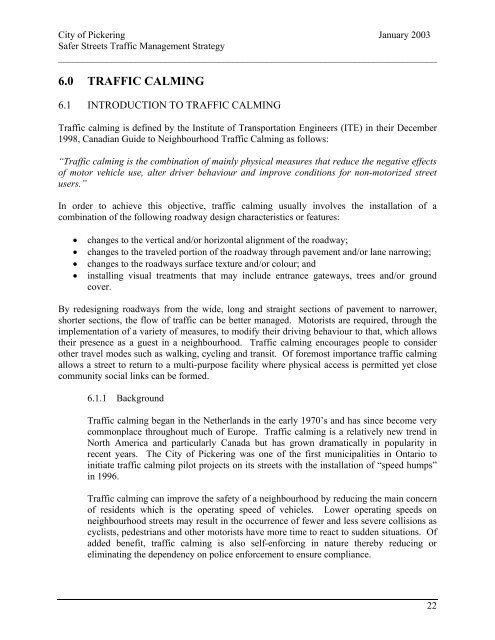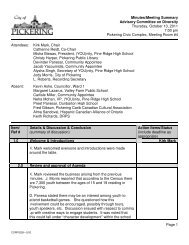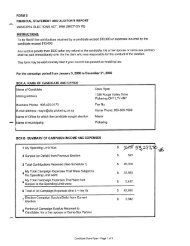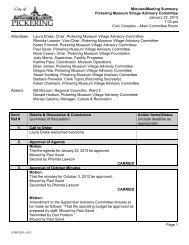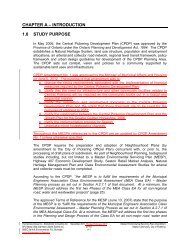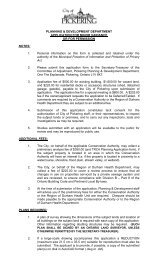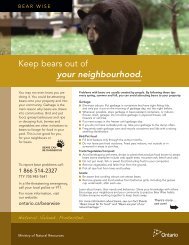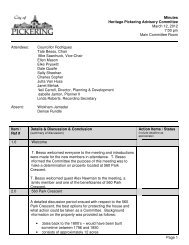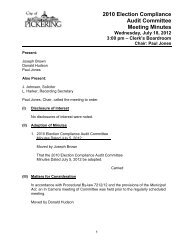foreword - City of Pickering
foreword - City of Pickering
foreword - City of Pickering
You also want an ePaper? Increase the reach of your titles
YUMPU automatically turns print PDFs into web optimized ePapers that Google loves.
<strong>City</strong> <strong>of</strong> <strong>Pickering</strong> January 2003<br />
Safer Streets Traffic Management Strategy<br />
______________________________________________________________________________<br />
6.0 TRAFFIC CALMING<br />
6.1 INTRODUCTION TO TRAFFIC CALMING<br />
Traffic calming is defined by the Institute <strong>of</strong> Transportation Engineers (ITE) in their December<br />
1998, Canadian Guide to Neighbourhood Traffic Calming as follows:<br />
“Traffic calming is the combination <strong>of</strong> mainly physical measures that reduce the negative effects<br />
<strong>of</strong> motor vehicle use, alter driver behaviour and improve conditions for non-motorized street<br />
users.”<br />
In order to achieve this objective, traffic calming usually involves the installation <strong>of</strong> a<br />
combination <strong>of</strong> the following roadway design characteristics or features:<br />
<br />
<br />
<br />
<br />
changes to the vertical and/or horizontal alignment <strong>of</strong> the roadway;<br />
changes to the traveled portion <strong>of</strong> the roadway through pavement and/or lane narrowing;<br />
changes to the roadways surface texture and/or colour; and<br />
installing visual treatments that may include entrance gateways, trees and/or ground<br />
cover.<br />
By redesigning roadways from the wide, long and straight sections <strong>of</strong> pavement to narrower,<br />
shorter sections, the flow <strong>of</strong> traffic can be better managed. Motorists are required, through the<br />
implementation <strong>of</strong> a variety <strong>of</strong> measures, to modify their driving behaviour to that, which allows<br />
their presence as a guest in a neighbourhood. Traffic calming encourages people to consider<br />
other travel modes such as walking, cycling and transit. Of foremost importance traffic calming<br />
allows a street to return to a multi-purpose facility where physical access is permitted yet close<br />
community social links can be formed.<br />
6.1.1 Background<br />
Traffic calming began in the Netherlands in the early 1970’s and has since become very<br />
commonplace throughout much <strong>of</strong> Europe. Traffic calming is a relatively new trend in<br />
North America and particularly Canada but has grown dramatically in popularity in<br />
recent years. The <strong>City</strong> <strong>of</strong> <strong>Pickering</strong> was one <strong>of</strong> the first municipalities in Ontario to<br />
initiate traffic calming pilot projects on its streets with the installation <strong>of</strong> “speed humps”<br />
in 1996.<br />
Traffic calming can improve the safety <strong>of</strong> a neighbourhood by reducing the main concern<br />
<strong>of</strong> residents which is the operating speed <strong>of</strong> vehicles. Lower operating speeds on<br />
neighbourhood streets may result in the occurrence <strong>of</strong> fewer and less severe collisions as<br />
cyclists, pedestrians and other motorists have more time to react to sudden situations. Of<br />
added benefit, traffic calming is also self-enforcing in nature thereby reducing or<br />
eliminating the dependency on police enforcement to ensure compliance.<br />
22


